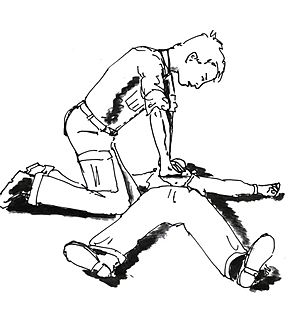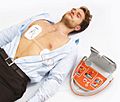Cardiopulmonary resuscitation facts for kids
Cardiopulmonary resuscitation (CPR) is a very important set of actions. You do CPR when someone stops breathing or their heart stops beating. The main goal of CPR is to keep blood and oxygen moving through their body. Every part of the body needs blood and oxygen to stay alive. CPR doesn't restart a heart that has stopped. But it can keep blood and oxygen flowing long enough to prevent damage to the body from not getting enough oxygen.
Contents
What is CPR and Why is it Important?
There are different ways to do CPR. What you do depends on if you are a regular person or a medical expert.
How Anyone Can Help (Bystander CPR)
Even if you are not a doctor or nurse, you can still help a lot! Here are the key steps:
- Notice the problem: Realize that a person has suddenly collapsed or is not breathing.
- Call for help: Quickly call 911 (or your country's emergency telephone number). This brings professional help.
- Start chest compressions: Push hard and fast in the middle of the person's chest. Aim for the breastbone. Keep pushing until medical help arrives. This action forces blood to keep flowing to the brain and other important body parts.
How Medical Experts Help
Medical professionals, like paramedics and doctors, have more tools and training. They can do everything a regular person can, plus more:
- Use a defibrillator: They can use a machine called a defibrillator. This machine gives an electric shock to the heart. It won't restart a heart that isn't beating at all. But if the heart is beating in a very abnormal way, the shock might help it return to a normal rhythm.
- Give medicines: If the heart isn't beating, they can give special medicines. Examples include epinephrine or atropine. These medicines can sometimes help restart the heart. They can also give medicines to make an abnormally beating heart go back to normal.
- Help with breathing: They can help get oxygen into a patient's lungs in a few ways:
- Using a bag-valve-mask: They place a mask over the patient's face. Then they squeeze a bag filled with oxygen that is attached to the mask.
- Placing a tube: They can put a tube down a patient's throat. This is called intubation. It delivers oxygen more directly to the lungs.
- Use an artificial pacemaker: Sometimes, they can use an artificial pacemaker. This device helps the heart beat at a steady speed and rhythm.
Why Every Second Counts in CPR
Time is extremely important when someone needs CPR. Every minute that passes before CPR starts lowers the chance of survival by about ten percent. This means acting fast is super critical!
If CPR begins within the first three to five minutes, and a defibrillator is available, the chance of survival can be very high. It can be as high as 50% or even 75%. This means one out of two, or even three out of four people, can survive!
In many places, emergency services take about eight minutes or more to arrive after being called. Because of this, a person's survival often depends on the people who are already there. A quick call to emergency services and starting basic CPR right away can greatly increase the chance of survival. This is true for both adults and children.
Images for kids
-
CPR training: CPR is being given while a second helper gets ready for defibrillation.
See also
 In Spanish: Reanimación cardiopulmonar para niños
In Spanish: Reanimación cardiopulmonar para niños










